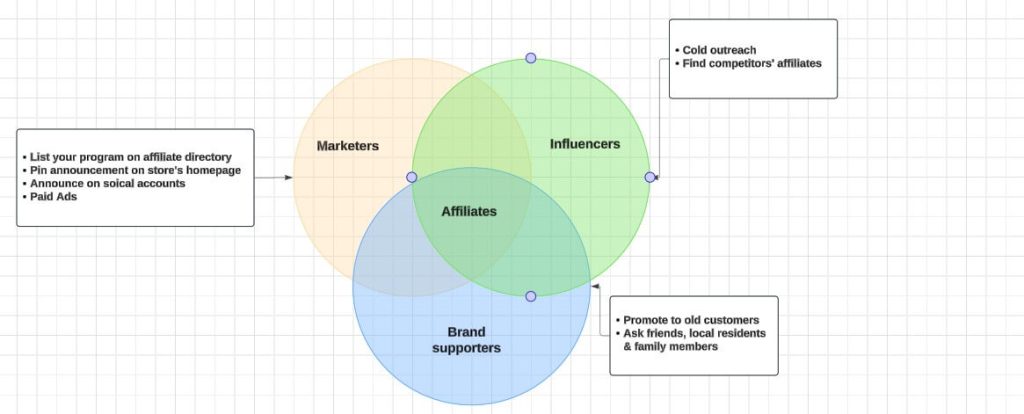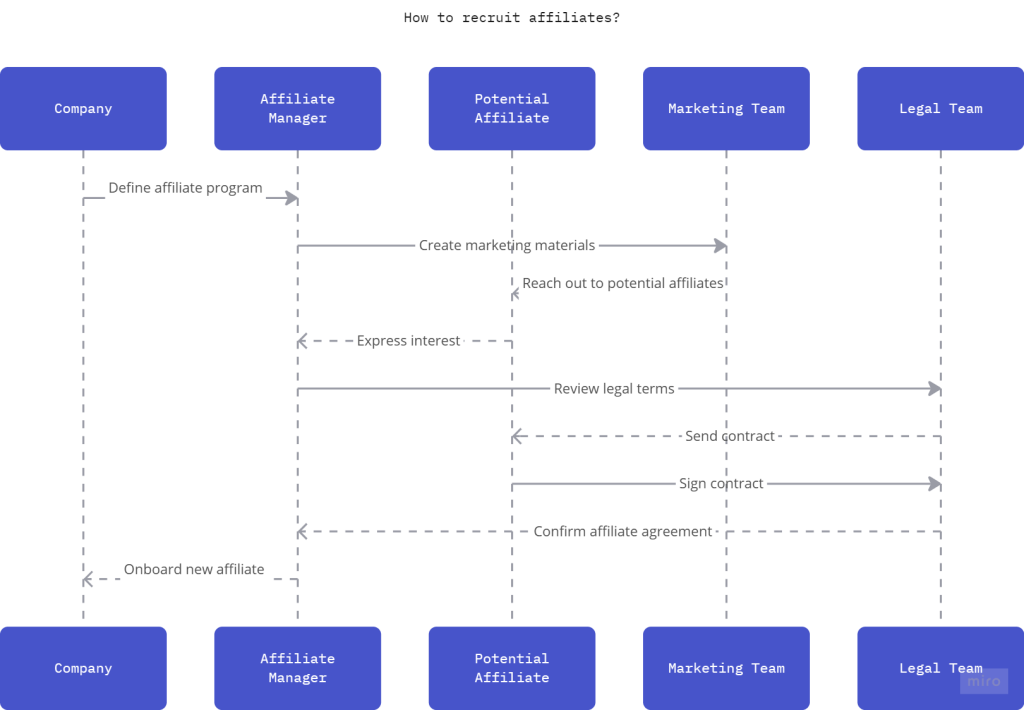Affiliate marketing is one of the top three customer acquisition channels for 54% of marketers, and 20% rank it as their most successful channel. With the right strategy, your affiliate program can become a powerful marketing channel, helping you tap into new markets and boost brand visibility.
But how do you recruit the right affiliates to join your program?
In this article, we’ll walk you through proven 11 strategies to help you successfully recruit affiliates.

11 strategies to recruit affiliates
Recruiting affiliates is more than just sending out invites or spam your program on the internet. It’s about building connections and offering value. Whether you’re starting fresh or looking to expand your affiliate network, we suggest to conduct a quick research (to see which affiliate is suitable to your brand) before applying 11 proven approaches below.
Note that each strategy may target a specific type of affiliate, but not all. For example, our first suggested strategy target at existing customer base only.

1. Turn loyal customers into affiliates
Loyal customers are often the best candidates for becoming affiliates, as they already have a deep understanding of your brand, products, and the value you offer. Tapping into this group can keep them engage with your brand but also help you create a network of motivated affiliates who genuinely believe in what you’re offering.
- Identify loyal customers
Start by identifying customers who consistently engage with your brand, whether through repeat purchases, high-value orders, or frequent interactions with your marketing content.
Look for customers who have shared positive feedback, left glowing reviews, or actively promoted your products on social media.
If a customer frequently buys from your online store and shares photos of your products on Instagram, they’re likely a great candidate for your affiliate program.
- Send personalized invitations
Once you’ve identified potential affiliates from your loyal customer base, send them personalized invitations to join your affiliate program. Explain how they can earn commissions by promoting products they already love.
Include the benefits of the affiliate program, such as the commission structure, available marketing tools, and support.
- Offer incentives to encourage participation
Offer special perks to loyal customers who sign up as affiliates. This could include a higher commission rate for their first few sales, bonus rewards for referrals, or exclusive discounts for their own purchases.
2. Collaborate with influencers on social media

Social media influencers can play a key role in helping you recruit affiliates. Influencers have established audiences who trust their recommendations, and by collaborating with them, you can tap into their following to promote your affiliate program. Partnering with influencers not only helps you reach new potential affiliates but also increases brand visibility and credibility.
In general, an influencer get paid promotion from brand while earning commission for their referral at the same time. That’s why, in many case, influencers can be seen as a part of your affiliate networks.
- Identify the right influencers
To effectively collaborate with influencers, it’s important to choose those whose audience aligns with your brand. Look for influencers who share content related to your niche, have engaged followers, and share values similar to your brand.
- Create engaging content with influencers
Work with influencers to create content that not only promotes your affiliate program but also encourages their followers to join and become affiliates. This could include co-branded posts, video shout-outs, or even live sessions discussing the benefits of becoming an affiliate.
For example: A fashion influencer posts a video on Instagram wearing your products and includes a CTA like, “Join our affiliate program and start earning commissions on products you love – link in bio!”
- Leverage affiliate program referral links
Allow influencers to use unique referral links to share your affiliate program with their followers. This makes it easy for their audience to sign up and join the program through an influencer’s personalized link.
- Use paid collaborations to boost visibility
If your budget allows, consider using paid social media collaborations with influencers to promote your affiliate program. Paid campaigns can help you reach a wider audience and drive more sign-ups.
Collaborating with influencers on social media is a powerful way to recruit affiliates and increase brand awareness.
3. Announce on your homepage

Your website’s homepage is one of the most visited pages and is an ideal place to inform visitors about your affiliate program. By strategically announcing your program here, you can attract potential affiliates who are already engaged with your brand.
- Highlight your affiliate program with a banner
Add a banner to the top or middle of your homepage, showcasing your affiliate program with a clear call-to-action (CTA).
- Dedicate a section on the homepage
Use a specific section on your homepage to introduce your affiliate program. Include a short description, key benefits, and a clickable button leading to more details.
For example, a section titled, “Earn With Us” explains, “Sign up for our affiliate program and earn up to 20% commission on every sale you refer. No upfront cost, just opportunities to earn.”
- Link to a dedicated affiliate landing page
Ensure the homepage announcement links directly to an affiliate landing page. This page should provide comprehensive information, testimonials, and a sign-up form.
- Use visuals and testimonials
Enhance the announcement with visuals, like icons or images, and include testimonials from successful affiliates to build credibility and trust.
- Keep the announcement updated
If your program has limited-time offers or bonuses, highlight them in the homepage announcement to create urgency.
Announcing your affiliate program on your homepage ensures maximum visibility for your affiliate recruitment process.
4. Add on the navigation bar (menu & footage)
Making your affiliate program easy to discover on your website is essential for attracting potential affiliates. Adding a dedicated link in your navigation bar and footer increases visibility and ensures interested parties can find the information effortlessly.
- Include a link in your main navigation menu
Incorporate a “Join our affiliate program” link in the primary navigation bar of your website. This ensures it’s visible to visitors as they browse your site. Place a link labeled “Affiliate Program” alongside your primary categories like “Products” or “About Us” in your site’s menu.
- Add the program to your footer
The footer is often a go-to area for visitors looking for additional resources. Including your affiliate program here makes it easily accessible from every page.
Example: Add a “Become an Affiliate” link in the footer under a section like “Company” or “Resources.”
- Link to a dedicated affiliate page
Both the menu and footer links should direct visitors to a detailed affiliate landing page. This page should highlight program benefits, commission structures, and instructions for joining.
Example: Use a landing page with testimonials from top-performing affiliates, FAQs, and a call-to-action like “Sign up to start earning today!”
5. Partner with niche bloggers

Niche bloggers are powerful allies in your affiliate recruitment efforts. These bloggers have highly targeted audiences who trust their recommendations, making them ideal partners for your affiliate program. By forming partnerships with niche bloggers, you can attract affiliates who are genuinely passionate about your brand and products.
- Pitch your affiliate program to bloggers
Search for bloggers whose content aligns with your industry or product offerings. Focus on bloggers with an engaged audience rather than just high traffic numbers. Reach out to bloggers with a personalized email introducing your affiliate program and highlighting the benefits of joining. Emphasize how their audience can benefit from your products and how they can earn commissions.
- Collaborate on blog content
Partner with bloggers to create engaging, value-driven content, such as a guide to become an affiliate, the perks of your program, etc
- Showcase successful partnerships
Highlight existing partnerships with niche bloggers to encourage others to join your program. Showcase testimonials, case studies, or examples of bloggers who have achieved success as your affiliates.
- Build long-term relationships
Treat niche bloggers as valued partners by maintaining open communication, sharing performance updates, and providing marketing resources to help them succeed.
6. List your program on affiliate marketplaces
Affiliate marketplaces are centralized platforms where merchants connect with affiliates looking for programs to join. By listing your affiliate program on these marketplaces, you can reach a wide pool of potential affiliates who are already experienced in promoting products.
- Choose the right affiliate marketplace
Select marketplaces that cater to your niche or have a large network of affiliates. Some platforms also specialize in specific industries, such as fashion, tech, or finance.
Use platforms like ShareASale, CJ Affiliate, or Rakuten Advertising for a general audience. For specific niches, consider BixGrow if you’re a Shopify merchants or Awin for global outreach.
- Optimize your program listing
Create an appealing and detailed listing to attract affiliates. Highlight key benefits, such as commission rates, payout methods, and unique selling points of your program.
A well-crafted listing might state: “Earn up to 20% commission on every sale! Weekly payouts, free marketing tools, and access to exclusive promotions.”
- Highlight competitive advantages
Showcase what makes your program stand out from others in the marketplace. Affiliates are more likely to join programs that offer high commissions, exclusive tools, or easy-to-sell products.
- Leverage marketplace tools
Many affiliate marketplaces provide affiliate recruitment tools like affiliate analytics, promotional resources, and automated payouts to make program management easier. Take advantage of these features to support your affiliates and improve their performance.
- Promote your program within the marketplace
Invest in marketplace advertising or featured listings to increase your program’s visibility. This is especially useful for new programs trying to stand out in competitive marketplaces.
7. Engage in relevant online communities

Online communities are hubs of potential affiliates who are already passionate about your industry. Engaging with these groups helps you find affiliates who are genuinely interested in promoting your products and services.
- Identify suitable communities
Look for communities where your target affiliates gather. These can include forums, Facebook groups, LinkedIn groups, or niche platforms related to your industry.
Example: For a fitness brand, join communities like Reddit’s r/fitness or niche Facebook groups for personal trainers and wellness enthusiasts.
- Participate actively and authentically
Build credibility by contributing value before promoting your affiliate program. Share insights, answer questions, and engage in discussions to establish trust within the community. Once you’ve built trust, share details about your affiliate program, ensuring your promotion aligns with the community’s rules and values.
- Leverage niche communities
Some online communities are highly specific and focused, making them ideal for finding affiliates with the right audience.
For example, a tech company could engage in platforms like Hacker News or Tech-specific Discord servers to attract affiliates who are tech-savvy.
- Monitor engagement and feedback
Track the effectiveness of your efforts in these communities. Pay attention to how members respond and refine your approach to maximize results.
Affiliate recruiting in online communities requires contributing value and strategically promoting your program.
8. Send personalized outreach emails to recruit potential affiliates

Outreach emails are a powerful way to recruit affiliates by directly targeting individuals who align with your brand. A well-crafted, personalized email can grab attention, communicate your program’s value, and convince potential affiliates to join.
- Craft a compelling subject line
Your subject line is the first thing recipients see, so make it catchy and relevant to spark interest. Example: “Partner with us and earn up to 25% commission!” or “Exclusive affiliate opportunity for [their niche] creators.”
- Personalize your email content
Tailor the message to the recipient by referencing their work and explaining how your program aligns with their audience. You should avoid generic templates.
Example: “Hi [Name], I’ve been following your [blog/social media account], and I love your recent post about [specific topic]. I think your audience would find our [product/service] valuable, and I’d love to invite you to join our affiliate program.”
- Provide an easy next step
Include a clear call-to-action (CTA) with a direct link to sign up or learn more about your affiliate program.
- Follow up with potential affiliates
Send a polite follow-up email if you don’t receive a response within a week. Ensure your tone remains friendly and non-intrusive.
- Use email marketing tools for scalability
If reaching out to many potential affiliates, consider using email marketing tools like Mailchimp or HubSpot to manage and track your outreach campaigns.
By sending personalized emails, you can directly engage with potential affiliates, making them feel valued and excited to collaborate. Thoughtful outreach fosters relationships that can lead to long-term partnerships.
9. Paid ads to recruit affiliate

Paid ads on social media or Google are a highly effective way to reach potential affiliates who are active on platforms like Facebook, Instagram, LinkedIn, and TikTok. With precise targeting and compelling ad creatives, you can attract affiliates who align with your brand’s goals
- Select the right platform for your ads
Choose the platform where your target affiliates are most active. Each platform has unique strengths that cater to different audiences. Use LinkedIn Ads to target professionals and niche bloggers or Instagram Ads to attract influencers and content creators.
- Create compelling ad creatives
Design eye-catching visuals and write persuasive copy that communicates the benefits of joining your affiliate program. Use a clear call-to-action (CTA).
An Instagram carousel ad might say:
Slide 1: “Love sharing products with your audience?”
Slide 2: “Join our affiliate program and earn up to 20% commission!”
Slide 3: “Sign up today and start earning: [link].”
- Use retargeting ads
Run retargeting campaigns to re-engage users who’ve visited your affiliate page but didn’t sign up. This can boost conversion rates.
- Monitor and optimize your campaigns
Use analytics tools to track ad performance and refine your campaigns based on metrics like click-through rates (CTR), cost-per-click (CPC), and sign-ups. You can use A/B to test different ad creatives on Instagram to see which version drives more affiliate registrations.
- Budget for maximum ROI
Allocate your budget strategically, focusing on high-performing ads or platforms. Start with a small budget and scale up based on results.
Paid ads are a scalable and targeted way to recruit affiliates. By crafting engaging campaigns and using platform-specific strategies, you can connect with the right affiliates and grow your program effectively.
10. Create an affiliate landing page
How to recruit affiliate marketers? Affiliate landing page is one of the most popular methods. A dedicated affiliate landing page serves as the central hub for your affiliate program. It provides potential affiliates with all the essential information they need to understand the program, its benefits, and how to sign up.
- Explain how the program works and add CTA
Use simple and concise language to describe the process, from signing up to earning commissions. Clearly outline what affiliates can gain by joining your program, such as commission rates, exclusive tools, or performance-based rewards.
Place prominent “Sign Up” buttons or links throughout the page to encourage immediate action.
- Optimize for mobile users
Ensure the landing page is mobile-friendly, as many potential affiliates will access it via smartphones or tablets. Use responsive design so that all text, images, and forms display correctly on mobile devices.
- Include an FAQ section
Address common questions or concerns about your affiliate program to reduce friction and encourage sign-ups.
- Use analytics to track performance
Monitor visitor behavior on the landing page to identify areas for improvement, such as optimizing the CTA placement or refining the content. You can use Google Analytics to track metrics like bounce rate, click-through rate, and sign-up conversions.
11. Run the MLM affiliate program
An MLM (Multi-Level Marketing) affiliate program allows affiliates to earn commissions not only from their direct referrals but also from the affiliates they recruit. This structure incentivizes affiliates to recruit others, creating a network of promoters and potentially increasing your program’s reach exponentially.
- Explain how MLM works
Clearly describe the MLM structure to your affiliates. They will earn commissions from sales generated by their direct referrals and a percentage of sales from affiliates they recruit.
Example: “When you refer someone to our program, you earn a 20% commission on their sales. Plus, if they recruit others, you’ll earn a 5% commission from their referrals.”
- Design an attractive compensation plan
Create a compensation plan that is both appealing to affiliates and sustainable for your business. Make sure the payout structure is competitive enough to motivate affiliates to build their own teams.
- Ensure legal and ethical compliance
MLM programs can raise concerns if they aren’t structured correctly. Make sure your MLM program is compliant with local laws and regulations regarding pyramid schemes and fair business practices.
Avoid unrealistic income claims and make sure affiliates understand that earnings are based on actual sales, not just recruitment.
- Monitor the program closely
MLM programs require careful monitoring to ensure that affiliates are complying with the rules and that there are no fraudulent activities taking place.
Example: Regularly review your affiliates’ activities to ensure that they are promoting your products ethically and not simply focusing on recruitment without generating sales.
Running an MLM affiliate program can dramatically expand your affiliate network by leveraging the recruitment efforts of affiliates themselves. While it can be powerful for scaling, careful management and transparency are key to building a sustainable and compliant program.
Affiliate Recruitment Process
An efficient affiliate recruitment process brings the right people to your program while fostering collaboration. Here’s a streamlined approach with five key players:
- Company: Sets goals and resources for the program.
- Affiliate Manager: Oversees recruitment and builds relationships.
- Marketing Team: Promotes the program to attract affiliates.
- Potential Affiliates: Evaluate the program and its value.
- Legal Team: Ensures compliance with contracts and regulations.
Whether you’re starting out or optimizing, aligning these roles is essential for success.

1. Setting Up the Affiliate Program
The company starts by defining goals, commission structures, and target audiences for the affiliate program. These details are shared with the affiliate manager to guide the recruitment process.
Note for SMEs: If you’re running a small or medium enterprise, you might handle this step yourself. As the program owner, you’re well-placed to define goals and priorities directly.
2. Creating Affiliate Materials
The affiliate manager works with the marketing team to create essential materials, such as banners, social media content, and affiliate links. These assets play a crucial role in helping affiliates promote effectively. Check out our affiliate assets guide for tips on crafting impactful materials.
3. Recruiting Affiliates
The marketing team begins the outreach phase, leveraging social media, email campaigns, and affiliate networks to attract potential affiliates.
4. Affiliate Applications
Interested affiliates apply to the program, expressing their interest in collaboration.
5. Reviewing Program Structure and Legal Terms
Before proceeding, affiliates review the program structure, including commission terms and legal policies. Transparency here builds trust. For guidance, explore our legal guide for affiliates.
Note for SMEs: If you don’t have a dedicated legal team, you can handle this yourself by using ready-made templates like our affiliate agreement template.
6. Legal Team Prepares Contracts
The legal team drafts e-contracts that outline terms and responsibilities. This step ensures compliance and clarity for all parties.
7. Affiliates Sign Agreements
Once the contracts are sent, affiliates review and sign electronically, ensuring the process is swift and paperless.
8. Affiliate Management Confirmation
The affiliate manager reviews the signed agreements and confirms onboarding. Communication channels are established to assist affiliates throughout the program.
Note for SMEs: You can also oversee affiliate management personally to save costs and ensure a personal touch with your new affiliates.
9. Final Approval by the Company
The company provides the final confirmation, officially welcoming the affiliate into the program.
Note: In many companies, affiliate managers may handle approvals for individual affiliates. However, approval from higher management is often required for bulk onboarding or strategic partnerships. This ensures alignment with broader company goals, as affiliate marketing involves factors like the total number of affiliates, resource allocation for management, and marketing budgets.
Key Takeaway
Building a thriving affiliate program isn’t just about offering commissions, it’s about creating a community of passionate brand advocates who can help drive your business forward. By tapping into strategies like converting loyal customers into affiliates, collaborating with influencers, and using targeted outreach, you can recruit affiliates who genuinely resonate with your brand.
A well-organized affiliate recruitment process ensures smooth onboarding and sets the stage for long-term partnerships. Each stakeholder’s collaboration plays a vital role in achieving program success.
If you’re an SME, remember that you can streamline this process by wearing multiple hats, managing legal or marketing tasks directly, and using templates to save time. Ready to build your affiliate team? Start with these steps today!
Whether you’re promoting through social media ads, partnering with niche bloggers, or exploring the power of MLM structures, each method presents unique opportunities to expand your reach and boost your sales. But, as with any successful marketing strategy, consistency is key. Provide affiliates with the right tools, clear incentives, and a compelling offer, and you’ll cultivate a network that’s not just effective but enthusiastic.